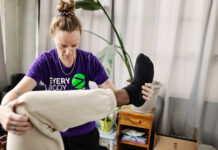
All back pain has a cause – understanding this is the key to beating pain. A proper assessment reveals the motions, postures and loads that cause pain versus ones that do not.
This evidence-based approach resulted from 32 years of lab and clinical investigations. The first objective is to stop the cause to allow the pain to desensitize – typically this is simply a matter of moving differently in combo with the right amount of activity. Second is to create a foundation for pain-free activity, guided by the understanding of the injury/pain history and impediments that thwarted recovery attempts. Third is to establish training goals and design the best program. Many patients with back pain often receive the blanket diagnosis: “You have ‘non-specific back pain.’” Clearly, these patients did not see an expert. The skill of assessing back pain is absent among many clinicians. Have you ever heard of ‘non-specific leg pain?’ Never. A leg specialist will assess the leg and the entire patient to determine the pain mechanism then recommend appropriate recovery strategies. Typically, these specialists take no more than 10 – 15 minutes with the patient. In contrast, a respectable/educated back specialist will guide the patient through an assessment demonstrating specific motions, postures and loads that trigger the specific pain.
A good back specialist will ask very specific questions, whereby the answers help interpret the triggers to hone in on a specific mechanism of pain.
Once triggers are understood, the objective is to avoid them. Adapt new ways to sit, tie your shoes, sleep, brush your teeth, lift your children, walk, etc.
Nearly all back pain can be controlled and altered.
The curious feature of most back pain is that you do not build up a resistance to the pain – rather more pain equates to more sensitization. Some clinicians resort to telling a patient to simply ‘work through the pain,’ and that ‘pain does not equal hurt or more tissue damage.’ They are very mistaken. These clinicians are likely quoting studies based on rodent muscle healing. Unlike an injury (ie: a broken leg) some mechanical back pain is associated with changes in the intervertebral discs. Hence, the mechanics of the joints change, placing more load on the facet joints (in some cases on nerves). Such changes alter the load sharing among the structures of the joints; it may take years for the joints to adapt.
The good news is that once these mechanisms are understood, the pain and mechanical changes can be accommodated to create tissue adaptations leading to less pain. Neglect of the mechanism can lead to adaptations counterproductive to reducing pain. The spine discs aren’t ball-and-socket joints like hip joints; they fall into the category of adaptable fabric. Appropriate activity toughens the discs; stretching them will often reduce load tolerance.
Laws that govern optimal spine function and resilience are unique. The secret that eludes so many is sourcing the right exercises, performed with the right dosage. Exercises are categorized by types of imposed stress. The body adapts to stress. Wrong exercises equals more pain. Match stress to the tolerance and to the specific pain mechanism to establish foundations for pain-free movement and a greater awareness of your body.
Test Your Posture
- Sit tall on a stool and grab the seat pan with your hands and pull up about 10 kg to compress your spine. You may notice no pain.
- Now slouch and repeat the compression.
- If you trigger familiar pain, you have just identified that forward flexion is a pain trigger.
- Next, arch your spine backwards and repeat the compression to explore if extension is a pain trigger.
















